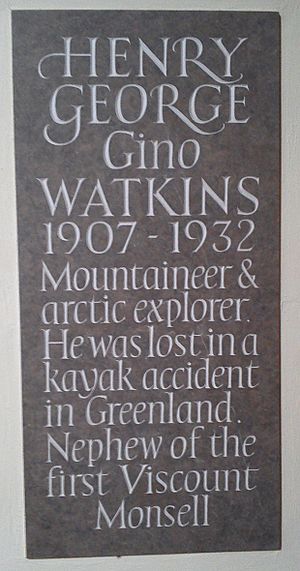Gino Watkins facts for kids
Henry George "Gino" Watkins (born January 29, 1907 – disappeared around August 20, 1932) was a brave British explorer. He was famous for his trips to the Arctic, a very cold region near the North Pole. He was also a Fellow of the Royal Geographical Society, which means he was a respected member of a group that supports geography and exploration.
Contents
Gino Watkins' Early Life and Adventures
Gino Watkins was born in London. He went to a school called Lancing College. From a young age, he loved being outdoors and climbing mountains. His father took him on holidays to places like the Alps and the Lake District in England. These trips helped him discover his passion for adventure.
While studying at the University of Cambridge, Gino became very interested in exploring the polar regions. His teacher, James Wordie, helped him learn more about these icy places. In the summer of 1927, Gino led his first expedition to Edgeøya, an island in the Arctic.
Learning to Fly and Exploring Labrador
Gino Watkins also learned how to fly airplanes. He was one of the first students in the Cambridge University Air Squadron. This skill would later be very useful for his expeditions.
From 1928 to 1929, Gino went on an expedition to Labrador, a region in Canada. He set up a base at North West River. During this trip, he explored many areas that had never been mapped before. He even discovered Snegamook Lake.
The British Arctic Air Route Expedition
Gino Watkins' most important adventure was the British Arctic Air Route Expedition. This happened between 1930 and 1931. Gino led a team of fourteen men. Their main goal was to map the east coast of Greenland. They also needed to check the weather conditions there. This information was important for a new air route planned from England to Winnipeg, Canada.
The expedition achieved all its goals. They also discovered a special rock formation called the Skaergaard intrusion. Gino and two friends, Percy Lemon and Augustine Courtauld, made an amazing journey. They traveled about 1,100 kilometers (600 nautical miles) in an open boat. They went around the King Frederick VI Coast in southern Greenland.
Achievements and Recognition
Because of this successful expedition, Gino Watkins became famous around the world. In 1932, he received the Founder's Medal from the Royal Geographical Society.
One member of Gino's team, Augustine Courtauld, spent a whole winter alone. He stayed at a weather station deep inside Greenland's ice. He collected the first weather data from this very remote place. Another team member was Freddie Spencer Chapman, an expert skier and naturalist. He later became famous as a soldier.
Gino's Last Expedition
After his big success, Gino wanted to lead an expedition to cross Antarctica. However, it was during the Great Depression, a time when money was very hard to find. So, he could not raise enough funds for this trip.
Instead, Gino returned to Greenland in 1932. He went with a small team on the 1932-33 East Greenland Expedition. They wanted to continue the work from his previous air route expedition. On August 20, 1932, Gino went hunting for seals in his kayak. He was in a place called Tuttilik (Tugtilik Fjord). Sadly, he never returned. Later that day, his friends found his empty kayak floating upside down. Gino's body was never found. There is a special memorial for him inside St Peter's Church in Dumbleton.
Honours and Legacy
In 1932, Gino Watkins was given the Hans Egede Medal. This award came from the Royal Danish Geographical Society.
There is also a special fund named after him, called the Gino Watkins Memorial Fund. The Royal Geographical Society and the University of Cambridge manage this fund. It provides money to help people go on polar expeditions.
Several places are named in Gino's honour:
- Watkins Island, a small island in the cold Southern Ocean.
- The Watkins Range, which is Greenland's highest mountain range.
- The Gino Watkins Glacier in New Zealand.
- The nearby peaks of Gino and Watkins on the Barrier Range.
Images for kids



